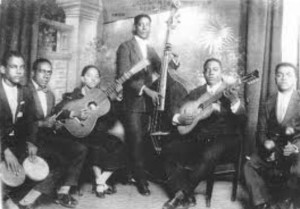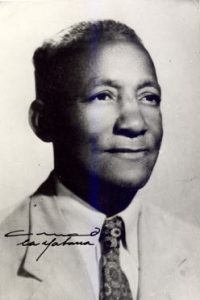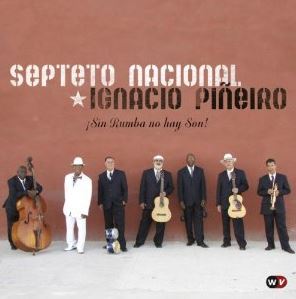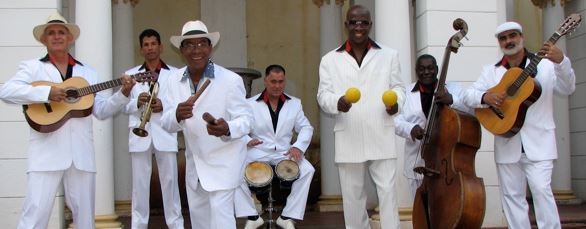The root of Salsa music is most closely associated to the Cuban rhythm of “Son”. The Septeto Nacional de Ignacio Piñeiro maintains the music of one of the main creators of Cuban “son”.
I had the opportunity to talk to Frank Oropesa, the musical director of this Cuban folkloric group that bears the name of Ignacio Piñeiro. Piñeiro was one of the strongest influencers of the early forms of Cuban “son”. “We just came from Puerto Rico, playing alongside El Gran Combo. There, Gilberto Santa Rosa came up to sing with us. Gilberto said in one of his improvisations that Salsa music was born out of the ‘son'” said Oropesa.
Frank recounts below the creation of the Septeto Nacional.
Piñeiro Founds the Septeto Nacional
“Ignacio Piñeiro was a true rumbero, an Abakwa, who had been part of the ‘guaguancó’ (rumba rhythm) groups ‘Timbre de Oro’ and ‘Coro y Guanguancó’. He liked the form of the original ‘son’ which came from eastern Cuba, and was later baptized “son oriental’. Piñeiro was a percussionist and learned to play the bass. He did not learn from Maria Teresa Vera, who was the director of the Sexteto Occidente; that is a myth. He joined Vera’s Sexteto Occidente already knowing how to play the bass very well” recounts Frank, who plays the bongo in the Septeto Nacional.

Oropesa continues…”In 1927, Ignacio Piñeiro seized the opportunity to form his own group. Contrary to another false myth, the Sexteto Occidental did not break up because Piñeiro took with him some of the musicians to this group. None of the original members of what he would eventually be the Septeto Nacional were from Maria Teresa Vera’s Sexteto Occidente.”
Piñeiro started his group with the same format, which was originally a Sexteto. He had six musicians which played bass, guitar, tres guitar, a bongo, and two singers. Of the two singers, one played the maracas and the other played the clave. Both of these instruments where incorporated by Piñeiro to the Cuban ‘son’ from his Abakwa rumbero background. After flirting with various names for the group, Piñeiro’s record label influenced his decision to name it the “Sexteto Nacional”.
Piñeiro Makes Changes to the “Son”

As a rumbero, Piñeiro had some ideas on how to change the “son” to achieve a different sound. He immediately added elements of “rumba” to the “son”. The most significant was the clave, and we already mentioned the maracas, used in the ‘coros abakwa’. The “son oriental” as originally performed by the Cuarteto Oriental and also by the famous Trio Matamorros, but they did not use the clave.
The 2nd important change Ignacio Piñeiro made was to add a trumpet as a lead instrument to the format. According to Frank Oropeza, the addition of these two important elements, the clave and the trumpet, “made the ‘son’ much more danceable”.
The now Septeto Nacional became instantly popular in their based city of Havana, and their popularity rapidly spread through the rest of Cuba.
The Septeto Nacional Goes International
Only two years after forming his group, the Septeto Nacional was selected to represent Cuba in the 1929 World Fair in Seville, Spain. It is said that on the boat trip to Spain via New York, Piñeiro composed the song “Suavecito”. It is said that during the boat trip, the group entertained the passengers playing their music. It is said that one of the woman liked to dance the “son” so much, that Piñeiro wrote the song and debuted it in the Seville World Fair. The Septato Habanaro ended winning an award in the fair.
The Septeto Nacional also participated in the 1933 World Fair in Chicago. That was the last time the group played in the United States until 2009, when the Obama administration eased the permissions for Cuban groups to perform in the U.S.
As the 30’s continued, some of the economic hardships impacting the U.S. during the depression years also affected Cuba. As Oropesa recounts; “the Septeto Nacional was not making much money, and in 1935 Piñeiro leaves the group to work as a marble craftsman in the Havana Capitol building construction project taking place at the time. This position paid well, and Piñeiro needed the money. Lazaro Herrera, who Ignacio Piñeiro had hired as his trumpet player, took over the group. However, he could only keep it together two more years. In 1937, the Septeto Nacional broke up.
Septeto Nacional Recent Grammy Nominations

Between the late 1930’s and early 1950’s there were brief gatherings and attempts to restart the Septeto Nacional. But it wasn’t until 1954 that the Septeto Nacional formed again for good.
The Septeto Nacional still encountered hard times. “The 1970’s were especially hard of the group. But the group continued and still continues up to this day. We are the 4th generation of the Septeto Nacional” said Oropesa.
In 2004, the group was nominated for a Grammy in the Best Traditional Tropical Latin Album category for their CD “Poetas del Son”. In this week’s Latin Grammy Awards, the Septeto Nacional is nominated for Best Traditional Tropical Latin Album for its album “La Habana Tiene Su Son”.
Frank said with great pride, “this is a great recognition to the older and newer music that the group has been composing and performing”.


[…] 1929 Ignacio Pineiro wrote and recorded the song “Suavecito” with his Septeto Nacional, which included the above lines, and became a huge hit. With that, he helped to popularize what had […]